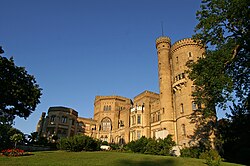| This article includes a list of general references, but it lacks sufficient corresponding inline citations. Please help to improve this article by introducing more precise citations. (June 2015) (Learn how and when to remove this message) |
| Babelsberg Palace | |
|---|---|
| Schloss Babelsberg | |
 Babelsberg Palace Babelsberg Palace | |
 | |
| General information | |
| Type | Palace |
| Architectural style | Gothic revival |
| Town or city | Potsdam |
| Country | Germany |
| Coordinates | 52°24′25″N 13°05′35″E / 52.407°N 13.093°E / 52.407; 13.093 |
| Construction started | 1833 |
| Completed | 1849 |
| Client | Prince (later Emperor) William I |
| Owner | Stiftung Preußische Schlösser und Gärten Berlin-Brandenburg |
| Design and construction | |
| Architect(s) | Karl Friedrich Schinkel Ludwig Persius Johann Heinrich Strack |
| Website | |
| Stiftung Preußische Schlösser und Gärten | |
| UNESCO World Heritage Site | |
| UNESCO World Heritage Site | |
| Part of | Palaces and Parks of Potsdam and Berlin |
| Criteria | Cultural: (i), (ii), (iv) |
| Reference | 532ter |
| Inscription | 1990 (14th Session) |
| Extensions | 1992, 1999 |
Babelsberg Palace (German: Schloss Babelsberg) lies in the eponymous park and quarter of Potsdam, the capital of the German state of Brandenburg, near Berlin. For over 50 years it was the summer residence of Prince William, later German Emperor William I and King of Prussia and his wife, Augusta of the House of Saxe-Weimar-Eisenach, German Empress and Queen of Prussia. Along with the surrounding park and other parks in the area, the Babelsberg Palace was inscribed on the UNESCO World Heritage list in 1990 for its architectural cohesion and its testimony to the power of the Prussian monarchy.
History
The building, designed in the English Gothic revival style, was built in two phases over the period 1833–1849. The contract to plan the palace was given to the architects Karl Friedrich Schinkel, who was in charge of the works until his death, in 1841, Ludwig Persius and Johann Heinrich Strack.
On 22 September 1862 in the palace and adjoining park the discussion between King William I of Prussia and Otto von Bismarck took place that ended with the nomination of Bismarck as Minister President and Foreign Minister of Prussia.
The architecture of Babelsberg Palace formed the template for the construction of Kittendorf Palace between 1848 and 1853 in Mecklenburg-Vorpommern, by Schinkel's pupil, Friedrich Hitzig.
World Heritage Site
Since 1990, Babelsberg Palace has been part of the UNESCO World Heritage Site "Palaces and Parks of Potsdam and Berlin". The palace is administered by the Stiftung Preußische Schlösser und Gärten Berlin-Brandenburg.
Since 2013, the palace has been undergoing an intense renovation of its facades and interiors.

Gallery
-
 Archangel Michael
Archangel Michael
-
 Eagle and vulture devouring a deer
Eagle and vulture devouring a deer
-
 Palace Tower
Palace Tower
-
The Palace of Prince Wilhelm at Babelsberg by Carl Daniel Freydanck, 1838
See also
References
- "Palaces and Parks of Potsdam and Berlin". UNESCO World Heritage Centre. United Nations Educational, Scientific, and Cultural Organization. Retrieved 12 Jun 2022.
- Amtlicher Führer der Stiftung Preußische Schlösser und Gärten Berlin-Brandenburg: Park und Schloss Babelsberg. 3rd edition, 1999
- Gert Streidt, Klaus Frahm: Potsdam. Die Schlösser und Gärten der Hohenzollern. Könemann Verlagsgesellschaft mbH. Cologne, 1996. ISBN 3-89508-238-4
- Georg Poensgen: Schloss Babelsberg. Deutscher Kunstverlag, Berlin 1929.
External links
52°24′28″N 13°05′36″E / 52.407639°N 13.093289°E / 52.407639; 13.093289
| Karl Friedrich Schinkel | |
|---|---|
| Architectural works |
|
| Paintings |
|
| Related | |
- Houses completed in 1849
- World Heritage Sites in Germany
- Palaces in Brandenburg
- Gothic Revival architecture in Germany
- Buildings and structures in Potsdam
- Tourist attractions in Potsdam
- 1849 establishments in Prussia
- Museums in Potsdam
- Historic house museums in Germany
- Royal residences in Brandenburg
- Karl Friedrich Schinkel buildings
- William I, German Emperor
